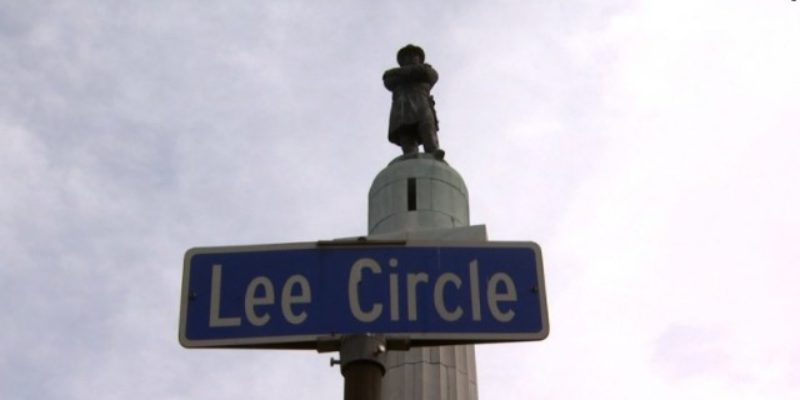The City of New Orleans is about to take possession of three priceless works of art that it does not own. The monuments have lined the cityscape for more than a century each. The city government did not provide funds to build or erect these now historic monuments.
Robert E. Lee was the first of the four historic monuments erected by New Orleanians in question at this time. After Lee’s death in 1870, a group of local citizens founded the Robert E. Lee Monumental Association of New Orleans. It took 14 years to raise the funds and build the monument to one of the most respected military leaders in American history. The hill, pyramid, column, and bronze statue were paid for by donations from the public, veterans, widows, mothers, fathers, and hundreds who lived under the thumb of Union occupation in the Crescent City. Alexander Doyle’s sculpture of Lee cost $10,000 in 1884. The unveiling drew an estimated 15,000 people to witness the event.
“I have now the honor of presenting the monument this day unveiled, through you [Mayor Behan] to the city of New Orleans,” said Judge Charles Fenner at the dedication in 1884. Fenner and the Lee Monumental Association entrusted it as a gift to the city, not city government. “Louisiana is entitled to a full share in the glory of Lee. Her sons illustrated by their valor every field on which his fable was won. To her chief city we confide this monument with the full assurance that she will appreciate it and preserve it as one of her most precious possessions.”
The Lee Monumental Association presented General Lee, raised on private funds, as a gift to New Orleans and Louisiana. The National Register for Historic Places added the Lee monument to its list in 1991.
Immediately following Jefferson Davis’ death in New Orleans in 1889, which drew 200,000 spectators and remains the largest funeral held in the city, a group of Southern journalists met in New Orleans and put forth an effort to build a monument to the U.S. Army veteran and statesman of both the United States and Confederate States. The group of journalists, which included representatives of the Times Democrat, States, Item, and Daily Picayune, ended up collaborating for the memorial in Richmond, not New Orleans.
Locally, the Jefferson Davis Memorial Association was founded in 1890. The group was entirely composed of women. They raised money by selling memberships (referred to as subscriptions), conducting auctions, sponsoring plays, and requesting funds from the national Daughters of the Confederacy organization. The Louisiana Legislature donated $500. 21 years later, after raising $20,000, the women of the Davis Memorial Association unveiled the statue of Jefferson Davis to New Orleans.
The Times Picayune wrote, “New Orleans is not only to have a monument of stone and bronze to Mr. Davis, but a never perishing memorial in the name of a street.”
Mayor Martin Behrman stated at the dedication that it gave him “infinite pleasure to officially turn over the site occupied by the monument into the keeping of the association, knowing that it would always be held sacred.”
The Jefferson Davis monument has been submitted for placement on the National Register of Historic Places.
After the death of Louisiana’s homegrown hero G.T. Beauregard in 1893, the Beauregard Monument Association organized. The fundraising process spanned a longer period of time than any of the other monuments. Many of the original BMA board members died. The funds trickled in through small donations, ranging from 37 cents to $2,000. Thousands of donors–widows, wives, daughters, veterans, sons, mothers, fathers, and regular citizens–purchased subscriptions to support memorializing the local veteran. The Louisiana Legislature contributed $500. It took 22 years to raise the $22,000 that covered costs for the pedestal and bronze equestrian statue of Louisiana’s Beauregard. And in 1915 the people of New Orleans and Louisiana finally had G.T. Beauregard, masterfully sculpted by Alexander Doyle, riding horseback at the entrance to City Park. The National Register for Historic Places added it to its list in 1999.
These monuments were intended to stand the test of time, as noted at each dedication. Their existence calls for education and understanding of the past. Removing them is erasing history by every measure. They tell the history of not just the men cast in bronze, but of the city, state, and a short lived country. They tell the story of the women of New Orleans who raised scraps of money until they eventually produced beautiful art work to improve the city. That history is a part of New Orleans that will vanish when these monuments go into an obscure storage area.
Mayor Mitch Landrieu views these monuments, paid for by thousands of individuals, as the City Government’s property, to do with as he pleases. Landrieu said so in a March 2017 statement which began, “Today the Fifth Circuit Court of Appeals affirmed the City’s ability to control its property.” His Liberty Place statement in April 2017 included, “We have affirmed the city’s right to control its property…” And he classifies and specifically identifies the three monuments as “city property” on a regular basis.
Ownership is complicated. The Louisiana Legislature contributed funds to the Beauregard and Davis monuments. All of the monuments were commissioned with monetary gifts from the people of Louisiana. Beauregard and Lee are nationally recognized works of art. They have been in New Orleans ranging from 102 to 133 years. New Orleans the place, not the government, and Louisiana and the nation have been in possession of them for more than a century.
The historic monuments that the mayor is pretending to own are not the city of New Orleans’ “property.” Any claim on them is nothing more than Mitch Landrieu looting the city of its gifted historic artwork.
Advertisement
Advertisement

